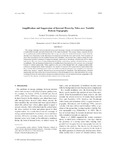Amplification and suppression of internal waves by tides over variable bottom topography
| dc.contributor.author | Vlasenko, Vasyl | |
| dc.contributor.author | Stashchuk, Nataliya | |
| dc.date.accessioned | 2015-11-29T09:55:19Z | |
| dc.date.available | 2015-11-29T09:55:19Z | |
| dc.date.issued | 2006-01-01 | |
| dc.identifier.issn | 0022-3670 | |
| dc.identifier.issn | 1520-0485 | |
| dc.identifier.uri | http://hdl.handle.net/10026.1/3856 | |
| dc.description.abstract |
<jats:title>Abstract</jats:title> <jats:p>The energy exchange between internal waves and barotropic currents over inclined bottom topography is studied theoretically and in the framework of the numerical model. The energy balance equation derived for a continuously stratified fluid predicts that energy can either be transferred toward or away from the internal wave depending on the direction of propagation of both the wave and current. Four scenarios of wave–flow interaction over the inclined bottom were identified. An internal wave extracts energy from the background tidal flow during its propagation upslope–upstream or downslope–downstream and its amplitude grows. The wave loses energy propagating downslope–upstream or upslope–downstream and reduces in amplitude. This mechanism of suppression or amplification of internal waves by a current over an inclined bottom is verified numerically. When applied to the area of the Knight Inlet sill, a high-resolution fully nonlinear, nonhydrostatic model reproduces the packets of internal waves generated by supercritical tidal flow over the sill. Careful inspection of the wave fields revealed the presence of an irregular wave structure within wave packets—namely, internal waves are not arranged by amplitude. This phenomenon, obtained numerically and observed in situ, is treated in terms of the mechanism of wave–flow interaction: the energy exchange between the tidal current and generated internal waves over the inclined bottom topography is the reason for the absence of traditional rank-ordered waves in the packet.</jats:p> | |
| dc.format.extent | 1959-1973 | |
| dc.language | en | |
| dc.language.iso | en | |
| dc.publisher | American Meteorological Society | |
| dc.title | Amplification and suppression of internal waves by tides over variable bottom topography | |
| dc.type | journal-article | |
| dc.type | Journal Article | |
| plymouth.author-url | https://www.webofscience.com/api/gateway?GWVersion=2&SrcApp=PARTNER_APP&SrcAuth=LinksAMR&KeyUT=WOS:000241559000006&DestLinkType=FullRecord&DestApp=ALL_WOS&UsrCustomerID=11bb513d99f797142bcfeffcc58ea008 | |
| plymouth.issue | 10 | |
| plymouth.volume | 36 | |
| plymouth.publication-status | Published | |
| plymouth.journal | Journal of Physical Oceanography | |
| dc.identifier.doi | 10.1175/jpo2958.1 | |
| plymouth.organisational-group | /Plymouth | |
| plymouth.organisational-group | /Plymouth/Faculty of Science and Engineering | |
| plymouth.organisational-group | /Plymouth/Faculty of Science and Engineering/School of Biological and Marine Sciences | |
| plymouth.organisational-group | /Plymouth/REF 2021 Researchers by UoA | |
| plymouth.organisational-group | /Plymouth/REF 2021 Researchers by UoA/UoA07 Earth Systems and Environmental Sciences | |
| plymouth.organisational-group | /Plymouth/Research Groups | |
| plymouth.organisational-group | /Plymouth/Research Groups/Marine Institute | |
| plymouth.organisational-group | /Plymouth/Users by role | |
| plymouth.organisational-group | /Plymouth/Users by role/Academics | |
| dc.identifier.eissn | 1520-0485 | |
| dc.rights.embargoperiod | Not known | |
| rioxxterms.versionofrecord | 10.1175/jpo2958.1 | |
| rioxxterms.licenseref.uri | http://www.rioxx.net/licenses/all-rights-reserved | |
| rioxxterms.type | Journal Article/Review |


